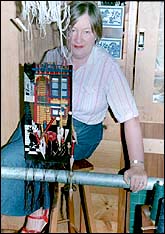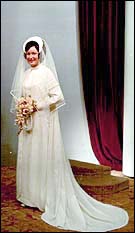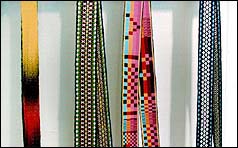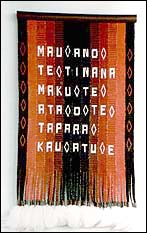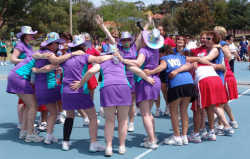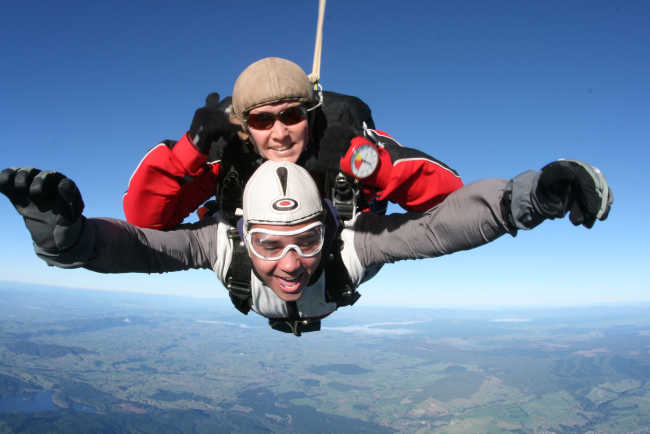Dorothy – 5/3/99
The craft of weaving a changing art form since the 1950s.
|
|
| Elizabeth Arnold in her studio |
The work of Elizabeth Arnold, well-known New Zealand weaver, has reflected
the changes.
It all began at the Ilam School of Fine Arts. In 1965, while a student of the Ilam School of Fine Arts at the University
of Canterbury, Elizabeth was fascinated by the looms in the design department. She had completed the first year compulsory course on the
basic subjects – painting, drawing, sculpture, design and written papers.
Specialising in textiles The second year offered the chance to specialise. She chose to work on
textiles. In addition to weaving and fabric printing the course covered
basic design, illustration, graphics, lettering, fabric techniques, fashion
design and photography, including all film techniques.
Tutors well known as artists in New Zealand Flo Akins taught weaving and was in charge of the textiles department. This vital woman has retained her interest in art and at age ninety two
visited Wellington for the opening of Te Papa.
Eileen Mayo, known for her illustrations and designs for stamps and for
tapestry taught design, and Doris Lusk, a well-known painter of New Zealand
landscapes, taught drawing.
Course work During the course Elizabeth wove lengths of fabric for day wear and a full
length evening dress, and samplers in various techniques. She also printed
fabrics. She learnt to hand-spin yarns in wool, linen flax and cotton. The
course included fashion photography and the creation of garments. She studied the history of textiles, fibres and costumes, and the processes for
producing fabrics and dyes commercially.
Imported yarns and looms, but local spinning wheels At that time it was difficult to procure good yarns, and the students used
linen yarn imported from Switzerland, cottons and other fibres from the
Kensington Weavers in London, and equipment, especially looms, from the
English firm, Dryad. Spinning wheels were locally made – the early Ashford
wheels.
Students would go to factories producing fabrics or knitwear and plead for
their mill ends so that they could use finer wools. The Kaiapoi and Mosgiel Woollen Mills would supply the thicker, blanket-type wools.
Elizabeth valued the course as being very comprehensive, looking at wool
from the sheep’s back to the finished product and the marketing, and likewise studying plant fibres in depth. As far as she is aware no course
dealing as comprehensively with textiles is offered in New Zealand at present.
Research into early use of dyes by Maori For a special project she chose to research the use of dyes by early Maori,
particularly the black dye obtained from coprosmas, New Zealand indigenous
plants, but also the black, reddish and ochre-coloured dyes used mostly
for the taaniko bands on Maori cloaks and other woven articles. The tukutuku (panels in the meeting houses) were woven from pingao, a natural
coloured plant found in sand dunes and keikie from the forest – an epiphyte
that grows in the forks of trees. The black dye was obtained from coprosma
bark and then steeped in a special type of mud which made it turn black.
Elizabeth did her own experiments and kept a diary of the results.
Teaching her craft Wanting to share her skills Elizabeth moved next to the Teachers’ College
and after graduation taught at Queen’s High School in Dunedin until in 1972
she moved to Wellington Girls’ College.
Marriage and a very special wedding dress
|
|
| Elizabeth in her hand woven wedding dress |
For her marriage to Wellington engineer Bill Arnold in 1971 Elizabeth hand
wove a fabric of fine cream wool for her wedding dress.
Exhibitions of Elizabeth’s work While she was still a student Elizabeth exhibited a tapestry weaving in
natural wool in Christchurch, and fabrics she had designed and woven were
shown at the Wool Expo in Dunedin in 1969.
Since then she has exhibited work almost every year. In 1975 at the Weavers’ Exhibition at the Dowse Art Gallery in Lower Hutt Elizabeth won
her first award for a large tapestry weaving bought by Foreign Affairs for
the New Zealand Embassy in Moscow. It was called “Rock Overhang or Tauwhare” and was based on a rocky overhang in a cave on the South Island
West Coast.
It was made with natural and synthetic dyes on wool. Much of it Elizabeth
hand spun herself. The surface was not flat, but adorned with the wrapped
elements which were popular at that time.
Fine narrow weaving a new exhibition style As guest exhibitor at the National Woolcrafts Festival (NWFE) in Hamilton
in 1976 she exhibited her narrow weaving for the first time, showing braids
and tapestries made in wool and cotton. By then better yarns were available. They were acceptable at this time, whereas in the sixties and
early seventies only the natural-coloured hand-spun wool had been accepted
for exhibitions.
|
|
| Examples of tablet-woven braids: including (1) a tie-dyed woollen braid, left, (2 and 4) two braids in No 8 mercerised cotton, and (3) a double faced technique in very fine cotton. |
From 1977 on the work she exhibited included both large pieces of tapestry
weaving and finely woven braids. She won an award at the 1982 NWFE in Wellington, and again in the NWFE in Queenstown in 1984, this time for a
weaving incorporating double-faced tablet-woven braids with feathers and
leather finishing and a layered hand-felted three dimensional miniature.
|
|
| (1) A wall hanging in tablet-woven braid based on a Maori proverb |
|
|
| (2) Hand made felt miniature |
Diversification of styles In the eighties she worked on non-loom-based work supplementing her weaving
and resulting in mixed media work, still all in the textile field. Using
the now wide range of textile techniques to express her ideas she incorporated drawing in thread into the tapestries.
For the Pacific Link Exhibition held in the Richmond Art Gallery in Vancouver, Canada in 1986 she used a combination of tablet weaving and felt
in red and white.
|
|
| Title “Perception and Illusion” – Felt and tablet-woven braid – 2 pieces 310mm X 355mm each |
Current work Elizabeth continues to receive invitations to exhibit her work around the
world. At present she is working on shaped tapestry weaving, such as hexagonal pieces, on complex patterns on braids, ear-rings, and neckties,
and on tapestries with a political emphasis.
|
|
| Title “The Political Impostor – Send in the clowns. There ought to be clowns.” |
|
|
| Tapestry on the theme of the colonization of New Zealand Title “On this site in 1842, absolutely nothing happened.” |
Looking back Looking back at weaving since the fifties Elizabeth sees definite trends.
In the fifties, there was a revival of interest in weaving. In 1957 the
Weaving Guild was set up in Auckland by Lady Dorothea Turner, an influential leader in the early days of the New Zealand Spinning and Weaving Woolcraft Society. This group set up competitions and tried to improve the yarn supply for weavers. Most early weavers spun their own
yarn and made their own dyes.
As the revival of spinning and weaving as a craft took off in the sixties
groups formed around the country. As well as many local and national exhibitions an exhibition was held each year in conjunction with the National Woolcrafts Festival. Most exhibitors hand-wove or knitted work
made from handspun wool in natural vegetable dyed yarn.
Colours used A wide range of colours was used – shades of gold, orange, green, brown and
gray. Some New Zealand lichen dyes produced other colours like bluish
purples. Imported natural dye stuffs included woad, madder and indigo.
Workers in woolcraft did everything from scratch, starting with only the
fleece.
Kiwicraft This used a type of yarn produced by hand rolling rather than spinning with
a wheel or a spindle. It originated from Maori women’s technique of rolling flax fibre to produce yarn for taaniko and other forms of weaving.
This yarn looks like a long untwisted “roving”. It was used for knitting
and crochet.
The seventies – a time of experimenting This period saw a world-wide boom in hand weaving. Experimental work abounded with experiments in scale, in different fibres, in synthetic dyes
and in producing very large pieces. A large tapestry, Biennale, in Lausanne in Switzerland had a world wide influence.
Off-loom techniques such as macrame and knotting were popular, and shaped
weaving was tried. Three dimensional forms were used, and unusual fibres
such as goat hair, hemp and rope and non-textile elements were incorporated.
New Zealanders began to discover what was going on in the rest of the world
as overseas weavers exhibited work and tutored here for the first time.
The eighties and early nineties In the early eighties the Henry Moore tapestries were woven by The West
Dean Tapestry Studio from sketches done by Moore in the Underground during
World War 2.
The eighties saw a revival of interest in tapestry weaving. A Victorian
tapestry workshop was set up in Australia and internationally recognised
tapestry weavers came there to teach. Some conducted workshops in New Zealand. All this fostered interest in the craft.
The late nineties This period has seen a gradual decline in the popularity of hand weaving,
but the work that is produced shows more expertise and diversity.
Elizabeth feels that it is too close in time to the next phase in handcraft
to predict what will be most popular. Many people have taken up quilting.
Weaving now mainly a hobby Weaving now has become mainly the work of women, unlike the early years of
the revival when there were a lot of men like Peter Collingwood and Archie
Brennan. At an earlier time it was reasonably profitable, but it is now
hard for a weaver to support herself, so it has become a hobby, not an easy
career for exponents of the craft. It no longer enjoys the popularity of
the boom days in the revival during the sixties and seventies.

